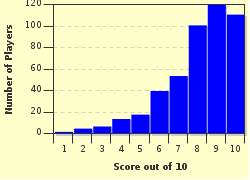Quiz Answer Key and Fun Facts
1. The Pythagorean theorem is a well-known principle in geometry. This theorem is named after a famous Greek philosopher and mathematician.
2. A famous modern law is Murphy's law. Which of the following best describes what this law states?
3. Johannes Kepler has lent his name to a law. In which field is this law applicable?
4. Amadeo Avogadro's name will always be associated with the Avogadro's law of gases. Who was Avogadro?
5. With which branch of science is Hubble's law associated?
6. Gregor Mendel was an Austrian friar whose name is associated with the Mendelian laws. What do Mendel's laws deal with?
7. Which of the following is a law of economics named after a famous economist?
8. An airplane flies in the sky because of the shape of its wings, which is explained by a famous law named after its creator; which is it?
9. Archimedes was a famous Roman King, after whom the famous Archimedes law related to buoyancy is named.
10. A famous principle by an economist is applied in business as '80% of sales comes from 20% of clients'. What is the principle known as?
Source: Author
deepakmr
This quiz was reviewed by FunTrivia editor
agony before going online.
Any errors found in FunTrivia content are routinely corrected through our feedback system.


